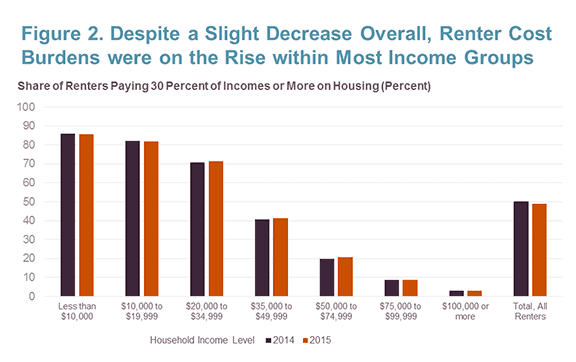 |
| by Dan McCue Senior Research Associate |
Source: JCHS tabulations of US Census Bureau, 2015 1-Year American Community Survey estimates via FactFinder
The data also show some improvement in the number and share of “severely burdened” renters (those paying 50 percent or more of their income on rent). However, this growth was not enough to return to the pre-recession levels of 2008 and earlier. Overall, the number of renters paying 50 percent or more on rents decreased from 11.50 million to 11.28 million in 2014–2015, which was the lowest number since 2010. The share of renters with severe burdens dropped from 26.6 percent of all renters in 2014 to 25.8 percent in 2015. This is the lowest rate recorded since 2008, when 25.0 percent of renters paid 50 percent or more of incomes on housing.
In addition, the decline in the overall number of cost-burdened renter households in 2015 masked some worsening of cost burden rates within many income groups (Figure 2). Among people earning $20,000-to-$34,999 annually (which in many areas is still a low and/or moderate income), the share of those who were cost-burdened rose from 70.8 percent in 2014 to 71.3 percent in 2015. While a much smaller share of renters making more than $35,000 a year are cost-burdened, there were modest (less than one-percentage point) increases in the share of cost-burdened households, for these renters as well. In comparison, while more than 80 percent of the renters who make less than $20,000 a year are cost-burdened, that figure fell by less than one percent between 2014 and 2015.
Source: JCHS tabulations of US Census Bureau, 2014 and 2015 1-Year ACS data.
Taken together, these shifts suggest that the overall decline in cost-burden rates for renters is due to growth in the number of renters with higher incomes and a decline in the number of low-income renters. While this could be viewed as a positive trend for renter households as a group, the fact that renter burden rates continue to grow within and among higher income groups suggests affordability problems are growing across the income spectrum and even for higher income groups.
Tomorrow, we’ll take a closer look at the improvement trends across various metropolitan areas.



No comments:
Post a Comment